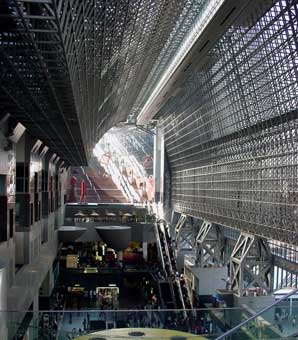
Kyoto is quite a place. Every where you turn there is history. Some of it up to 1200 years old maybe older. They say there are over 2000 temples and stuff in Kyoto. It's easy to believe when your there. Although it's a modern city you can't travel 2 minutes in any direction without finding some history.
I took my my Mom and Grandma in April 2001. We went for 3 days, 2 nights. I think it was just about the right amount of time. Although the temples are very cool. After a while they start to look all the same. I believe some of them have special festivals and that's probably the best time to see a particular one.
We took the Shikansen (bullet train) from Tokyo to Kyoto. The trip takes about 2 and a 1/2 hours and there's only one stop which is in Nagoya. Unfortunately the Shinkansen is expensive. $130 each way. If you are visiting from America and you are going to travel at all inside Japan I suggest you get a rail pass BEFORE you come to Japan. YOU CAN NOT GET THEM IN JAPAN. Just so you know. A rail pass will let you travel on any JR run train for free for a week or two weeks depending on which one you buy. JR = Japan Rail. It is one of the many train companies in Japan. Although it's the largest it's not the only one. For example there are about 7 train companies in Tokyo alone. JR, Eidan, Tokyu, Keikyu, Toei, Odakyu, Keio, Seibu. Wow, I just counted 8 and I didn't count them all. So, remember that you can only use your rail pass on JR lines. In other words don't expect to get everywhere for free. Still if you take the Shinkansen anywhere your pass will more than pay for itself.
We got to Kyoto at noon and decided it would be best to put our stuff in a locker and go site seeing immediately. We took cabs almost everywhere and it was never much more than $15. Note: We packed very lightly as we were only going to be there 2 nights. I fact I personally only had my student backpack.
The first thing you'll see when you get to Kyoto is most likely Kyoto station. It's ENORMOUS!!. I guess there was a lot of controversy when it was built because it's so big and I suppose arguably doesn't fit in with all the history. Personally though I think it fits perfect because I see Japan as a place of tradition and modern society all wrapped together. Girls walking around in Kimono talking on their cell phones for example 😉
You can probably spend a least a couple of hours looking around the station if you want. We ate lunch there and I introduced my Mom and Grandma to Shabu−Shabu.
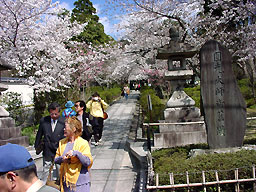
After lunch we caught a cab and asked him to take us some where cool in Gion. He dropped us of right in front of Maruyama Koen (Park) which is across the street from Gion. We decided to hit the park first instead of Gion.
Walking through the park it was clear the day before had been pretty busy for Hanami and it looked like it was going to be busy again. I think every night for the next couple of weeks there was some kind of night celebration in that area. We didn't check it out though.
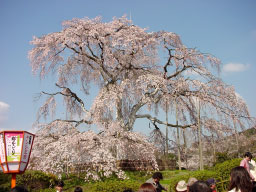
Continuing though the park we came upon some famous Sakura tree. I don't know the details but it was singled out and very beautiful. There were alot of people taking pictures and hanging out around the tree.
We also saw this little pile of gold. 😃 😃 😃

I suppose it's better than having it all in little pieces all over the place.
We kept walking up and up and the crowds were getting thinner and thinner and then we came upon this temple.
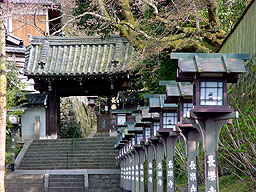
It didn't seem like it was a very visited temple and it was up a fairly steep hill. But we had not seen a temple yet and so we thought, what the heck. Let's check it out. We walked up to the admission gate. It turns out most of the temples have an admission. 300 to 600 yen (about 3 to 6 dollars U.S.)
They gave us a map of the area and told us we could go in the structure behind the admission area if we removed our shoes on the way in. I'm not sure what that building was. Maybe living quarters for somebody. Old Tatami mats, a few things but in the back was a beautiful private garden and there were some geta (wooden sandals) to slip on for you to take a look around.

After my Mom and Grandma looked around for what seemed like an eternity (just kidding ;−D) we proceeded up toward the temple. There was some kind of round stone area in the cliff in which there was a trickle of water coming out of a bamboo pipe up above and falling into a bucket. You could walk up to the bucket and there were ladles for scooping up some water. I don't know what it's supposed to mean but my Japanese friends have always told me it's supposed to be good look to wash your hands with that water. Almost every temple has some area with trickling water and ladles.
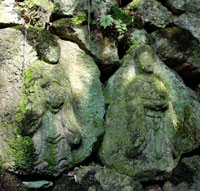
We eventually worked our way up to the temple. It was pretty small and there wasn't much to see up there and the map was a little confusing but we finally figured out that we could go up even higher on some ancient stone stairs that led up to a graveyard. Yes, in Japanese culture graveyards are considered a scary place at night just like in America. I wonder if that's a universal thing.
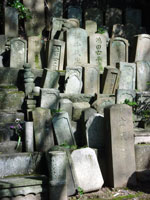
We made it up to the graveyard. I don't know if those are very old or not. I got the impression they were not all that old as they didn't look that worn although area seemed very old.
The graveyard went up several levels with the very top level being some fairly large grave. It would be pretty scary up there at night.
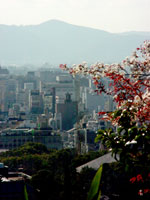
The coolest thing up there was the view. You could see all the way back down the hill all the way to where we got out of the taxi. It seemed a looonnngg way back.
If you check out the view on the right you can see the modern city of Kyoto down below.
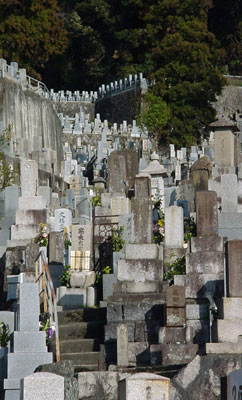
We walked back down the hill out of the temple back down past the admission point and walked in to the temple next door. Past that there was a very large cemetery going way up the hill.
At about that point walking south we started hitting the shops. Kyoto is famous for it's hand crafts and stuff. I'm not exactly sure how much of it is tradition and how much of it is just for tourists.
There are some cool things though. Lots of incense and not you typical vanilla, strawberry and patchouli but scents that seemed, at least to me, to be representative of Kyoto and,or maybe Japan in general. Almost every store was burning some even if they weren't selling any.
There were also lots of fan places. I forget what the Japanese word for fan is. There are at least two kinds. The kind that don't fold that come in the shape of a ping pong paddle. . I know those are called Uchiwa. They are often handed out for free in the hot summer with ads printed on the. The other kind is the kind that fold up that are the more familiar kind at least to Western eyes I don't remember the name but there were several stores that sold nothing but fans in every pattern for every budget.

At first we felt like ignoring them because we were tired from climbing all over that temple and graveyard in the hills but I finally checked the map while my Mom and Grandma were stuck in some store and figured out it was a large Buddha statue that we had seen from Kyoto Station.
We climbed the stairs and walked over to the admission area but it turns out it was closed on Monday's. Oh well, whatcha gonna do.
I did manage to get a picture off through the holes in the gate though.

From there we kept basically going south along the hills. There's, for lack of a better word, a shopping road that seems to go all the way from the park we started at to a temple called Kiyomizu−dera.
We never did end up making to that temple although I've been there before. The closer we got though the more crowed it got. There are lots of neat stores. Another thing you see alot of in Kyoto is pickles. I guess they're famous for pickles. Actually I bought some last time I was there 5 years ago and they were awful. It's possible they went bad though since I ate them a month after I bought them and I didn't refrigerate them. 😖
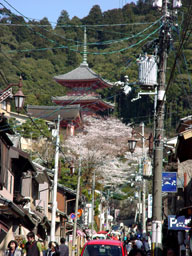
Another thing that was common to find is a kind of pastry that is specific to Kyoto. I think it's made of mochi and anko (sweet red beans) (like most Japanese traditional pastries). These ones come in a triangle shape. If you are going to get some try to get fresh ones. The mochi should be chewy almost like cookie dough. Get them from a store that sells only food. A gift store that sells a little of everything probably has mass made ones that have been sitting around for a while.
When you are living in Japan and go on a trip you are required to bring your co−workers or fellow students and friends some Omiyage (souvenirs). This is usually covered by buying a package/box of candy, cookies, pastries and then just opening the box at work and handing them out.
One other thing that we didn't do. There were several small Japanese dessert and tea restaurants with very beautiful gardens in that area that would have been fun to check out.
I had made plans to stay at a Ryokan (Japanese style inn) for the first night we were in Kyoto. I thought it would be a cool experience for my Mom and Grandmother.
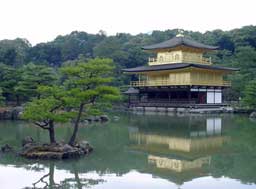
The next day we got up and took our stuff back to Kyoto station and put it in lockers. I might have been able to call our next hotel and been able to check in early but I just felt it was easier to do it this way.
From there my Mom wanted us to go see the Kyoto Imperial Palace which according to our guide book is only open a few weeks a year. There's an English speaking tour at 10am and 2pm but you have to sign up early. We took the subway from Kyoto Station and got there at around 9:50 and it took us a few minutes to figure out where to go so we ended up making an appointment for the 2pm tour.
So, I thought I'd take them to a couple of the more famous temples I had been to. We caught a cab to Kinkakuji (not to be confused with Ginkakuji, hard G). This is the famous golden temple. More than the temples, the grounds they are on are very beautiful.

One thing that was just a little disappointing though is that several of the temples are not the originals. Kinkakuji and the Kyoto Imperial Palace both burnt down at separate times and have seen been re−built. I think Kinkakuji burnt down in like the 1950s. The palace burnt down around 150 years ago or something like that.
From Kinkakuji you can walk to a few more temples. We walked to Ryoanji which is famous for it's raked rock garden. This is the temple that all those little personal rock gardens you can buy at places like The Nature Company in the states are based on.

The grounds there are also very beautiful and several cherry trees and other things were blooming.
There's a pond with a little island in the middle and a large garden opposite the entrance. All the gardens are super looked after and manicured.
Another thing, I think it's best to go on a weekday. I assume it's all alot more crowded on weekends than it is on weekdays.
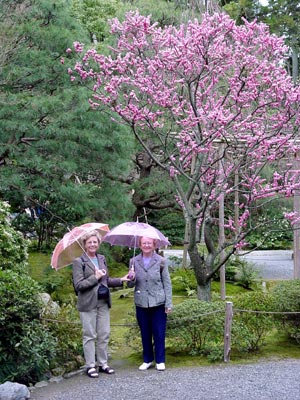
After that it was about 12:30 so we thought we should get some lunch and head back toward the Palace for our 2pm appointment.
We ended up eating at Mos Burger which is a very popular burger chain in Japan. Personally I like First Kitchen because they have 9 kinds of flavored fries and 5 kinds of sauces but most of my Japanese friends like Mos.
Maybe the problem is I never have a burger when I go to Mos. I always try one of their non−burger things and they never do it for me. My Mom and Grandma liked the burger though.
My Mom seemed to be way worried about my Grandma being able to eat in Japan and kept pushing us to have some western food once in a while but my Grandma seemed pretty much fine with everything I put in front of her (although I tried to make sure even if it was all Japanese that it was beef, pork or chicken. You're really missing out if you come to Japan and don't eat Japanese food. There's plenty that a non−fish eating middle American person should be able to eat. (As a side note there are picky Japanese people too that have to have to eat Japanese food every meal even when they are abroad)
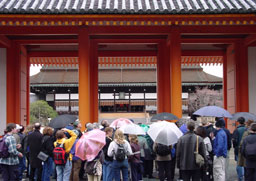
We made it to the Palace and went on the tour. The tour is about an hour and shows you all over the temple grounds (which if I remember correctly are on about 50 acres).
Personally the Palace didn't really do it for me. It's not as pretty as most of the temples. The best part was some of the explanations and history from the tour guide. For example the Emperor lived on a different building from his wife and children. He was also pretty busy. There where over 400 events a year he had to attend to. More than one a day.
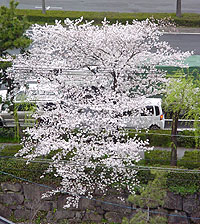
After the palace we we checked into our hotel. I had us booked at the Ana Nikko Hotel which is a nice 5 star hotel. Note: I had no idea we were going to stay at one of the best Ryokans and one of the best hotels. I had just gone into a travel agency and asked them to set me up and they took care of the rest.
From our hotel room on the 7th floor there was a nice view of Nikko Palace (I'm didn't read any of the history of that though). The hotel was also next to a subway station so after we checked in we decided to go to Gion for real this time.
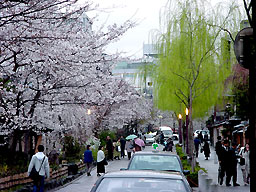
I'm not sure if we saw *real* Gion or not. We followed a path laid out in our guide book and we did find this very beautiful road lined with Sakura trees.
You can't see it in this picture but on the other side of the Sakura trees is a small river and on the other side of the river are all fancy Japanese restaurants with windows looking out to the river. I could see that there were big lights placed in the bushes to light up the trees at night so we came back at night. It was quite a sight.
Gion not only was the *pleasure* district but it still is. Outside the small old historic area there were blocks and blocks of hostess clubs and similar stuff. I'm not sure if it was obvious or not as all the signs are in Japanese. It's funny to me that there seems to be this contradiction where Geisha, because they have a long history or maybe because they look so different with their white makeup and stuff. Anyway, they are respected and yet hostess girls which have fundamentally exactly the same job are not respected, by both Japanese and Western society.
Also next to the Gion area is a rather large river and there were lots of restaurants looking out on the river. We decided to check them out for a place for dinner and I found a place that said they had Okonomiyaki, something I wanted my grandmother to try.
When we got in we were quickly ushered up to the 3rd floor which was full of foreign tourists and handed a simple menu with no Okonomiyaki on it. I thought maybe we were in the wrong place so I went out and asked the waiter about it and he told me that Okonomiyaki was on the 2nd floor. I guess most of the foreigners don't know what it is and so the restaurant plays it safe and keeps it simple for them.
We moved down to the second floor and I made Okonomiyaki for my Mom and Grandma. It was a little scary. I've done it a few times but almost never without Japanese supervision and the scariest thing was Okonomiyaki has a special sauce but it was not at the table. On top of which there is supposed to be a difference between western and eastern Okonomiyaki and I haven't been taught what the difference is. So, when it came time to put the sauce on and it was no where to be found (usually it's already at the table) I thought maybe that was one of the differences. No sauce. That would have really sucked because that's the most important part. There was some kind of sauce at the table that looked like a kind of soy sauce. Being the only thing around I thought, hmmm...Maybe I'm supposed to use this. Well, about 1/2 way through my internal panic (note, everybody else in the room is Japanese and is staring at this white guy making Okonomiyaki for his white Mom and Grandma so I'm ultra nervous, anyway, 1/2 way through putting a little soy sauce on the Okonomiyaki the waiter brings the right sauce. Horray!!. I announced to the onlookers in Japanese that I thought something was wrong but that I was too nervous to ask
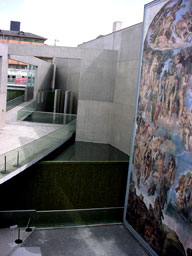
Fortunately Mom and Grandma really liked it (which I expected they would since I like it 😉)
The next day my Mom wanted to go to the Kyoto Garden of Fine Art and the Kyoto Botanical Gardens. The Kyoto Garden of Fine Art sounded kind of tacky in the guide book. Some place where they have western (European) reproductions on ceramic or something like that. Whatever. It was directly outside a subway station so we took the subway and checked it out. It was pretty small but it's really more about architecture than *fine art*.
A little bit strange. I guess some guy with alot of money decided he wanted to make this place. It's 3 floors, all out doors, all concrete with these huge reproductions of some western classic paintings and water falls running through the whole thing. We were probably only there 10 or 15 minutes but it was kind of interesting.

After that we went back to the station around noon with the intent to get some lunch and do some shopping at the station until 3:20 when our train back left. It turned out there was actually less shopping at the station then we thought. Well, most of it is fashion so outside of fashion there is not much shopping.
So, we went back to the first place we had gone where all the shops were between Maruyama Koen and Kiyomizu−dera and searched desperately for a tea pot my Mom had seen before and wanted to get for her sister. We looked in practically every store but she couldn't find it.
Oh well. We did have some cherry and green tea ice cream and I was able to buy some more Omiyage 😉